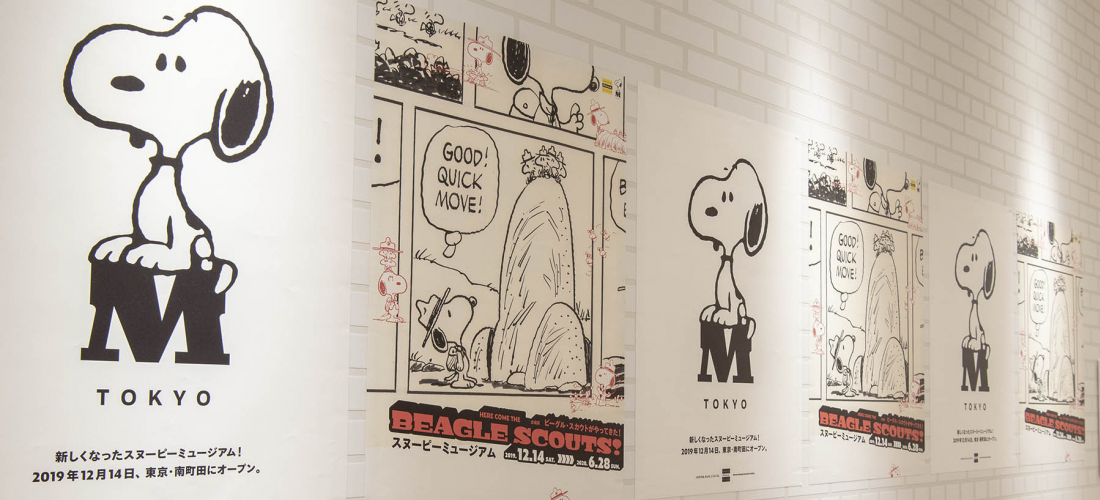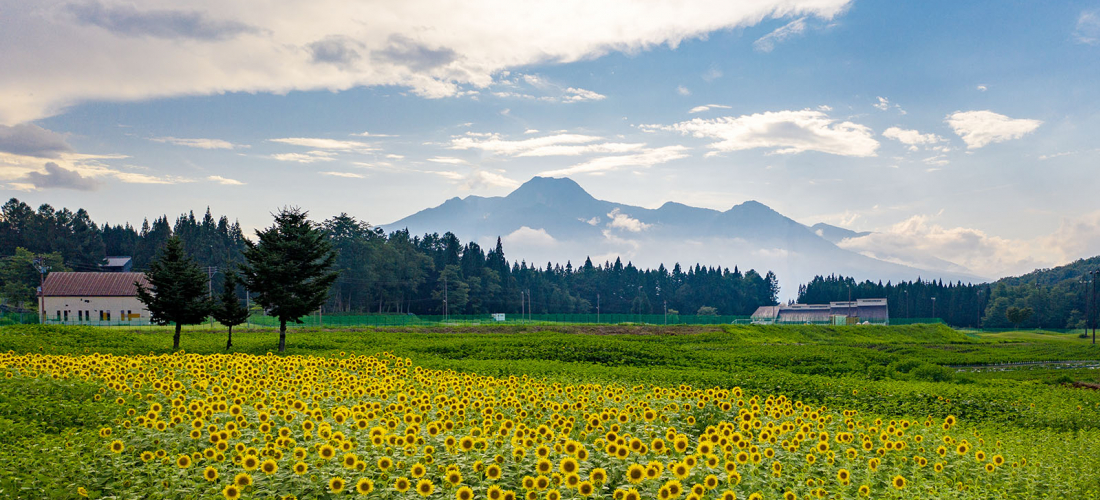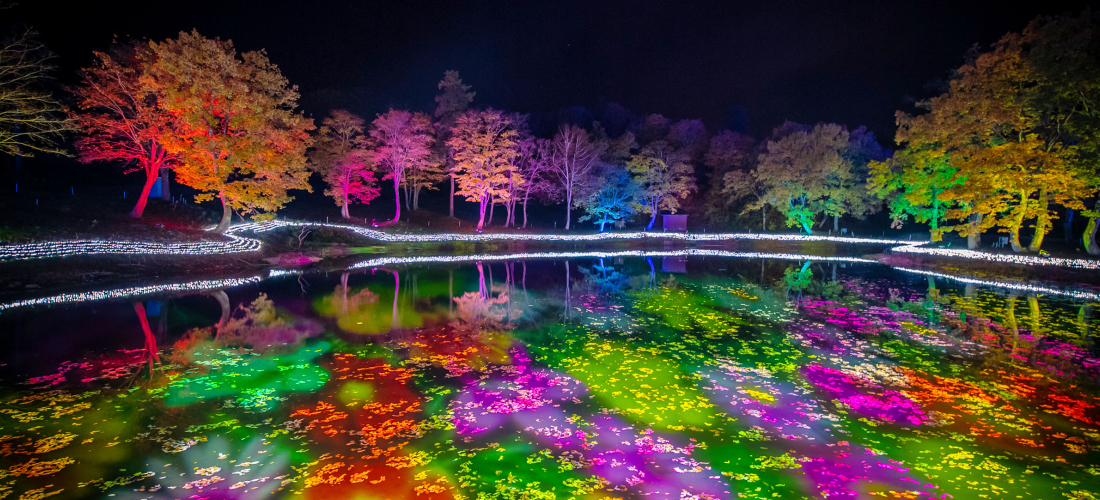
CONTENTS
Se promener dans les champs dorés de tournesols la journée, puis se perdre dans les néons du plus grand spectacle de lumières du Japon (APALLUSION) le soir. Voilà ce que vous réserve la magie de cet hôtel situé dans la prefecture de Niigata. Si vous aimez vous relaxer pendant vos voyages, nous vous recommandons fortement APA Joetsu-Myoko, parfait pour explorer les charmes du Japon au Nord de Honshu.
Profitez du charme des collines de Niigata
Pour cet été, nous nous sommes enfuis du bruit de la grande métropole pour nous rendre dans les collines de Joetsu-Myoko. Au Nord de la région de Chubu, la région centrale du Japon, les brises fraîches de Niigata roulant dans les forêts verdoyantes et les vallées aux alentours sont on ne peut plus parfaits pour réussir son voyage relaxant.
Nous avons déjà publié un article sur notre passion pour les onsen (sources chaudes naturelles), la nourriture délicieuse et le confort de l'hôtel APA Resort Joetsu-Myoko. Mais cette fois, nous allons vous faire découvrir les activités extérieures à faire autour. Si vous avez toujours rêvé de vous perdre dans les près et les champs de tournesol, la visite va vous plaire.
Admirez la fin de l’été au milieu des pétales dorés de tournesols.
Avec un ciel presque tout le temps bleu, la fin de l'été est le moment parfait pour profiter au maximum de APA Resort Joetsu-Myoko et de ses champs de tournesol du nom de Sunflower & Kochia Kingdom. Avec un million de fleurs (oui 1 000 000) de 27 sortes différentes, le paysage est à couper le souffle.
Et si vous arrivez un peu trop tard pour les tournesols, pas d'inquiétude, vous n'aurez qu'à vous rendre dans les champs de kochia qui se trouvent juste à côté!
Le meilleur moment pour voir les tournesols est généralement durant la deuxième moitié d'aout, mais cela peut dépendre du temps! Lorsque nous nous y sommes rendus l'été dernier en aout, il était encore un peu tôt et les champs n'avaient pas entièrement fleuri. Bien sûr, cela suffit à rendre le paysage époustoufflant, il n'y a donc pas de raisons de s'inquiéter d'arriver quelques jours trop en avance ou en retard.
Avec tant de sortes différentes, il est difficile de choisir quel type de tournesols est son préféré, mais nous vous conseillons tout de même de jeter un oeil sur les "tournesols de Monet" japonais, les "Van Gogh" ou encore les "Matisse" qui rappelleront les meilleures peintures impressionistes (pas seulement avec les noms qu'ils empruntent).
Image Source: Official Website
Ces buissons sont maintenant présents partout sur le globe mais ce sont bien les paysagistes japonais qui arrivent à faire des kochia de véritables oeuvres d'art, et Sunflower & Kochia Kingdom sera certainement le meilleur endroit pour les admirer. Avec 150 000 buissons de kochia, cela en fait le plus grand champ du Japon, rougissant avec l'automne et devenant un gigantesque tapis écarlate et touffu qui rappellera les pompons des pompom girls. La saison des kochia se situe entre début septembre et mi-novembre, ce qui vous laisse tout le temps nécessaire pour les admirer.
Normalement, le tarif d'entrée pour Sunflower & Kochia Kingdom coûtent 800 yens, mais cette année, une promotion spéciale pour les visiteurs étrangers vous permettra d'y entrer gratuitement en montrant votre passeport! Vous n'avez plus aucune excuse pour ne pas y aller.
Sunflower & Kochia Kingdom
1090 Okemi, Myoko, Niigata
Ouverture: 10 aout~ 17 novembre
Horaires d'aout: 10:00 – 18:00
Horaires Sep./Oct./Nov.: 10:00 – 17:00
Official Website (jp)
Une tasse de thé chez “Mon Ami”?
Après vous être perdus dans les champs de fleurs, il est temps de faire une pause. Après quelques minutes de marche, vous atteindrez une maison aux airs d'église qui est maintenant devenu un café singeant l'architecture européenne du nom de "Mon Ami".
La décoration intérieure n'a pas changé depuis le temps où c'était une véritable église, et le café est toujours éclairé par les vitraux de l'époque. En revanche les bancs ont été remplacés par des tables et des chaises bien plus confortables et placées de sorte à pouvoir admirer le paysage.
Le menu unique à ce café consiste à un thé anglais au thème du kochia et du tournesol. Si vous voulez rester dans le thème, ou que vous voulez simplement goûter à de supers gâteaux, ce menu propose également trois plateaux au choix. Des cakes au glaçage rose, des macarons à la mangue ou un ensemble de glace et d'autres macarons au thème du kochia et tournesol. Le troisième plateau consiste en une sélection de sandwichs sucrés au pain frais faits de la farine de riz. Une variété de boissons vous attendent également (avec bien sûr un super thé anglais parfait pour la pause goûter).
Garden Chapel Cafe Mon Ami
1090 Okemi, Myoko, Niigata
Horaires d'aout: 10:00 – 18:00
Horaires Sep./Oct./Nov.: 10:00 – 17:00
Official Website (jp)
Illuminez vos nuits dans le plus grand spectacle de lumière du Japon
Vous l'avez sûrement remarquez, mais APA Resort Joetsu-Myoko aime faire les choses en grand. Des champs comptabilisant 1 000 000 de tournesols, le plus grand tapis de kochia du Japon, mais aussi le plus grand spectacle de lumière de l'archipel. Les Japonais appellent ces champs de lumière "illuminations" et l'hôtel a nommé le siens APALLUSION. Nous avons déjà flâttée sa beauté dans un autre article.
APA Resort travaille constamment à rendre le lieu unique, et le rendu est juste époustoufflant.
Traversez une jungle peuplée d'animaux de lumière, avant d'évoluer au milieu de roses électriques, puis admirez les projections faites avec les dernières technologies.
APALLUSION est également gratuite cette année pour les visiteurs étrangers, à l'instar de Sunflower & Kochia Kingdom. N'oubliez pas votre passeport, car le tarif est normalement de 1 500 yens!
APALLUSION 2019
APA Resort Joetsu-Myoko (1090 Okemi, Myoko, Niigata)
Ouvert du 22 Juin au 17 Novembre
Horaires: Juin./Juil./Aout.: 18:00 – 23:00
Horaires : Sep./Oct./Nov.: 17:00 – 22:00
Official Website
Il est temps de reprendre de l’énergie dans les sources chaudes de Niigata
Voyager est souvent fatigant, mais Niigata vous offre l'endroit parfait pour reprendre des forces! Faites un bain de soleil durant la journée en admirant le paysage, puis rentrez à l'hôtel pour prendre cette fois-ci un vrai bain et vous reposer. Il n'y a rien de mieux que de se relaxer dans les sources chaudes avant de tomber de sommeil sur un matelas douillé. Nous avons écrit un article sur le confort des chambres du complexe la dernière fois que nous l'avons visité, et, croyez-nous, rien n'est mieux que d'ouvrir les rideaux sur un paysage montagneux sublime après une bonne nuit de sommeil.
Vous avez repris des forces? Alors en route!
Les chutes d’eau de Naena (苗名滝)
Le rugissement de la cascade de Naena peut s'entendre de très loin et vous comprendrez pourquoi lorsque vous vous approcherez. Cela vient d'un couloir d'eau en force de U qui tombe à plus de 55 mètres de haut sur les rochers en dessous. Vous pouvez y aller n'importe quand dans l'année, que ce soit en compagnie des feuilles vertes d'été et du printemps, des arbres rougissant d'automne, ou de la couverture blanche de la neige en hiver.
Le sanctuaire Togakushi (戸隠神社)
Nous avons déjà écrit un article sur l'histoire légendaire de ce sanctuaire ainsi que ses alentours resplendissants. Aujourd'hui, les visiteurs viennent se promener sur son chemin forestier qui est vieux de plus de 2 000 ans et est le lieux de plusieurs mythes de déitées Shinto.
Soba Togakushi (戸隠そば)
En compagnie de cornichons japonais et autres garnitures, les nouilles de Togakushi sont considérées comme l'un des trois meilleurs endroits pour manger du soba au Japon, avec les soba Wanko de Iwate, et les soba Izumo de Shimane.
Temple Zenkoji (善光寺)
Un autre trésor historique et religieux de la région, le temple bouddhiste Zenkoji, très différent du sanctuaire shinto Togakushi. Le temple de Zenkoji est vieux de 1 400 ans et est connu pour accueillir la plus vieille statue de Bouddha du Japon. Si vous cherchez à acheter des souvenirs, nous vous conseillons de rester autour et de chercher la rue Nakamise. Assez similaire sa grande soeur bien plus connue, la rue commerçante Nakamise d'Asakusa de Tokyo, vous y trouverez toutes sortes de produits à acheter et à manger (essayez par exemple la glace au miso).
Nous espérons que les photos de champs et de forêts verdoyantes et l'article ont été une lecture relaxante. Les mégalopoles telles que Tokyo et Osaka sont des destinations très populaires au Japon, mais ce n'est bien sûr pas pour tout le monde. Voilà pourquoi cela peut être une bonne idée de visiter un autre Japon, qui se situe à Niigata. Avec les entrées offertes pour the Sunflower & Kochia Kingdom et APALLUSION, vous n'avez aucune raison d'attendre pour venir!
Si vous voulez en savoir plus sur la région, lisez notre road trip jusqu'à Nagano! Et si vous préférez le train, nous avons aussi fait un voyage jusqu'à Toyama. Et n'hésitez pas à partager votre expérience du Japon (et vos photos) sur nos twitter, instagram, et facebook!
Details
NAME:APA Resort Joetsu-Myoko (アパリゾート上越妙高)
MAP
COMMENT
FEATURED MEDIA
VIEW MORE 
A New Tokyo Animal Destination: Relax & Learn About the World’s Animals in Japan
#pr #japankuru #anitouch #anitouchtokyodome #capybara #capybaracafe #animalcafe #tokyotrip #japantrip #카피바라 #애니터치 #아이와가볼만한곳 #도쿄여행 #가족여행 #東京旅遊 #東京親子景點 #日本動物互動體驗 #水豚泡澡 #東京巨蛋城 #เที่ยวญี่ปุ่น2025 #ที่เที่ยวครอบครัว #สวนสัตว์ในร่ม #TokyoDomeCity #anitouchtokyodome

Shohei Ohtani Collab Developed Products & Other Japanese Drugstore Recommendations From Kowa
#pr #japankuru
#kowa #syncronkowa #japanshopping #preworkout #postworkout #tokyoshopping #japantrip #일본쇼핑 #일본이온음료 #오타니 #오타니쇼헤이 #코와 #興和 #日本必買 #日本旅遊 #運動補充能量 #運動飲品 #ช้อปปิ้งญี่ปุ่น #เครื่องดื่มออกกำลังกาย #นักกีฬา #ผลิตภัณฑ์ญี่ปุ่น #อาหารเสริมญี่ปุ่น

도쿄 근교 당일치기 여행 추천! 작은 에도라 불리는 ‘가와고에’
세이부 ‘가와고에 패스(디지털)’ 하나면 편리하게 이동 + 가성비까지 완벽하게! 필름카메라 감성 가득한 레트로 거리 길거리 먹방부터 귀여움 끝판왕 핫플&포토 스폿까지 총집합!
Looking for day trips from Tokyo? Try Kawagoe, AKA Little Edo!
Use the SEIBU KAWAGOE PASS (Digital) for easy, affordable transportation!
Check out the historic streets of Kawagoe for some great street food and plenty of picturesque retro photo ops.
#pr #japankuru #도쿄근교여행 #가와고에 #가와고에패스 #세이부패스 #기모노체험 #가와고에여행 #도쿄여행코스 #도쿄근교당일치기 #세이부가와고에패스
#tokyotrip #kawagoe #tokyodaytrip #seibukawagoepass #kimono #japantrip

Hirakata Park, Osaka: Enjoy the Classic Japanese Theme Park Experience!
#pr #japankuru #hirakatapark #amusementpark #japantrip #osakatrip #familytrip #rollercoaster #retrôvibes #枚方公園 #大阪旅遊 #關西私房景點 #日本親子旅行 #日本遊樂園 #木造雲霄飛車 #히라카타파크 #สวนสนุกฮิราคาตะพาร์ค

🍵Love Matcha? Upgrade Your Matcha Experience With Tsujiri!
・160년 전통 일본 말차 브랜드 츠지리에서 말차 덕후들이 픽한 인기템만 골라봤어요
・抹茶控的天堂!甜點、餅乾、飲品一次滿足,連伴手禮都幫你列好清單了
・ส่องมัทฉะสุดฮิต พร้อมพาเที่ยวร้านดังในอุจิ เกียวโต
#pr #japankuru #matcha #matchalover #uji #kyoto #japantrip #ujimatcha #matchalatte #matchasweets #tsujiri #말차 #말차덕후 #츠지리 #교토여행 #말차라떼 #辻利抹茶 #抹茶控 #日本抹茶 #宇治 #宇治抹茶 #日本伴手禮 #抹茶拿鐵 #抹茶甜點 #มัทฉะ #ของฝากญี่ปุ่น #ชาเขียวญี่ปุ่น #ซึจิริ #เกียวโต

・What Is Nenaito? And How Does This Sleep Care Supplement Work?
・你的睡眠保健品——認識「睡眠茶氨酸錠」
・수면 케어 서플리먼트 ‘네나이토’란?
・ผลิตภัณฑ์เสริมอาหารดูแลการนอน “Nenaito(ネナイト)” คืออะไร?
#pr #japankuru #sleepcare #japanshopping #nenaito #sleepsupplement #asahi #睡眠茶氨酸錠 #睡眠保健 #朝日 #l茶胺酸 #日本藥妝 #日本必買 #일본쇼핑 #수면 #건강하자 #네나이토 #일본영양제 #อาหารเสริมญี่ปุ่น #ช้อปปิ้งญี่ปุ่น #ร้านขายยาญี่ปุ่น #ดูแลตัวเองก่อนนอน #อาซาฮิ

Japanese Drugstore Must-Buys! Essential Items from Hisamitsu® Pharmaceutical
#PR #japankuru #hisamitsu #salonpas #feitas #hisamitsupharmaceutical #japanshopping #tokyoshopping #traveltips #japanhaul #japantrip #japantravel

Whether you grew up with Dragon Ball or you just fell in love with Dragon Ball DAIMA, you'll like the newest JINS collab. Shop this limited-edition Dragon Ball accessory collection to find some of the best Dragon Ball merchandise in Japan!
>> Find out more at Japankuru.com! (link in bio)
#japankuru #dragonball #dragonballdaima #animecollab #japanshopping #jins #japaneseglasses #japantravel #animemerch #pr

This month, Japankuru teamed up with @official_korekoko to invite three influencers (originally from Thailand, China, and Taiwan) on a trip to Yokohama. Check out the article (in Chinese) on Japankuru.com for all of their travel tips and photography hints - and look forward to more cool collaborations coming soon!
【橫濱夜散策 x 教你怎麼拍出網美照 📸✨】
每次來日本玩,是不是都會先找旅日網紅的推薦清單?
這次,我們邀請擁有日本豐富旅遊經驗的🇹🇭泰國、🇨🇳中國、🇹🇼台灣網紅,帶你走進夜晚的橫濱!從玩樂路線到拍照技巧,教你怎麼拍出最美的夜景照。那些熟悉的景點,換個視角說不定會有新發現~快跟他們一起出發吧!
#japankuru #橫濱紅磚倉庫 #汽車道 #中華街 #yokohama #japankuru #橫濱紅磚倉庫 #汽車道 #中華街 #yokohama #yokohamaredbrickwarehouse #yokohamachinatown

If you’re a fan of Vivienne Westwood's Japanese designs, and you’re looking forward to shopping in Harajuku this summer, we’ve got important news for you. Vivienne Westwood RED LABEL Laforet Harajuku is now closed for renovations - but the grand reopening is scheduled for July!
>> Find out more at Japankuru.com! (link in bio)
#japankuru #viviennewestwood #harajuku #omotesando #viviennewestwoodredlabel #viviennewestwoodjapan #비비안웨스트우드 #오모테산도 #하라주쿠 #日本購物 #薇薇安魏斯伍德 #日本時尚 #原宿 #表參道 #japantrip #japanshopping #pr

Ready to see TeamLab in Kyoto!? At TeamLab Biovortex Kyoto, the collective is taking their acclaimed immersive art and bringing it to Japan's ancient capital. We can't wait to see it for ourselves this autumn!
>> Find out more at Japankuru.com! (link in bio)
#japankuru #teamlab #teamlabbiovortex #kyoto #kyototrip #japantravel #artnews
Photos courtesy of teamLab, Exhibition view of teamLab Biovortex Kyoto, 2025, Kyoto ® teamLab, courtesy Pace Gallery

Japanese Makeup Shopping • A Trip to Kamakura & Enoshima With Canmake’s Cool-Toned Summer Makeup
#pr #canmake #enoshima #enoden #에노시마 #캔메이크 #japanesemakeup #japanesecosmetics

⚔️The Robot Restaurant is gone, but the Samurai Restaurant is here to take its place. Check it out, and don't forget your coupon!
🍣신주쿠의 명소 로봇 레스토랑이 사무라이 레스토랑으로 부활! 절찬 쿠폰 발급중
💃18歲以上才能入場的歌舞秀,和你想的不一樣!拿好優惠券去看看~
#tokyo #shinjuku #samurairestaurant #robotrestaurant #tokyotrip #도쿄여행 #신주쿠 #사무라이레스토랑 #이색체험 #할인이벤트 #歌舞伎町 #東京景點 #武士餐廳 #日本表演 #日本文化體驗 #japankuru #japantrip #japantravel #japanlovers #japan_of_insta

Japanese appliance & electronics shopping with our KOJIMA x BicCamera coupon!
用JAPANKURU的KOJIMA x BicCamera優惠券買這些正好❤️
코지마 x 빅 카메라 쿠폰으로 일본 가전 제품 쇼핑하기
#pr #japankuru #japanshopping #kojima #biccamera #japaneseskincare #yaman #dji #osmopocket3 #skincaredevice #日本購物 #美容儀 #相機 #雅萌 #日本家電 #일본여행 #면세 #여행꿀팁 #일본쇼핑리스트 #쿠폰 #일본쇼핑 #일본브랜드 #할인 #코지마 #빅카메라 #japankurucoupon

















































